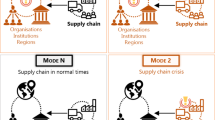Abstract
In this paper, we introduce a value chain approach, on the view of the value chain analytic in business management, to be the framework of a crisis response system serving for crisis management strategy in identifying risk sources, responding to unexpected events, and recovering from a shock. This system is not only a computer system but also a system of governmental emergency response mechanism and it is tremendous and complex. The system integrates and coordinates the correlative resources of emergency response units of the city. We consider the efficiency of the system. In addition, the run cost of the system also is taken into account. Based on this framework, the Qingdao’s practical situation is analyzed. As a result, a design proposal of the Qingdao’s crisis response system is put forward.



Similar content being viewed by others
References
Bjom H, Olsen DH, Sena JA (1996) The vale chain component in a decision support system: a case example. IEEE Trans Eng Manage 43(4):418–428
Chi XY, Xuan GL (2000) Summarization on the research of value chain. Foreign Econ Manage 22(1):25–31
Dymon UJ (2003) An analysis of emergency map symbology. Int J Emerg Manage 1(3):227–237
John M, Bryson, Barbara C, Crosby (1992) Leadership for the common good—tackling public problems in a shared power world. Jossey-Bass, San Francisco, CA pp 36–37
Kelly C (1995) A framework for improving operational effectiveness and cost efficiency in emergency planning and response. Disaster Prev Manage 4(3):25–31
Liang Qi H , Chi H, Zhao H (2006) Development of the emergency management capacity of emergent public events. Manage Rev 18(4):35–45
Louise K, Comfort, Mark Dunn, David Johnson (2004) Coordination in complex systems: increasing efficiency in disaster mitigation and response. Int J Emerg Manage 2(1/2):62–80
Maohua Zhong, Tiemin Liu, Feng Geng (2006) The current construction status of China emergency systems against major industrial accidents. Int J Emerg Manage 3(2/3):101–113
McEntire, David A (2003) Searching for a holistic paradigm and policy guide: a proposal for the future of emergency management. Int J Emerg Manage 1(4):298–308
Porter ME (1985) The competitive advantage. Free Press, New York
Qiong X (2005) Considering of public crises emergency management system. J Yangtze Univ (Social Sciences) 28(5):79–83
Timothy Coombs W (1999) Ongoing crisis communication-planning, managing, and responding. Sage, New York
Zhang XM, Chen GH, Zhang H (2006) Study on shortcomings of emergency management system in China and its development countermeasures. China Saf Sci J 16(2):79–85
Author information
Authors and Affiliations
Corresponding author
Rights and permissions
About this article
Cite this article
Li, J.H., Zhang, Z.P., Jing, R.H. et al. A value chain approach to crisis response system: the case of Qingdao. Stoch Environ Res Risk Assess 23, 485–492 (2009). https://doi.org/10.1007/s00477-008-0235-5
Published:
Issue Date:
DOI: https://doi.org/10.1007/s00477-008-0235-5




